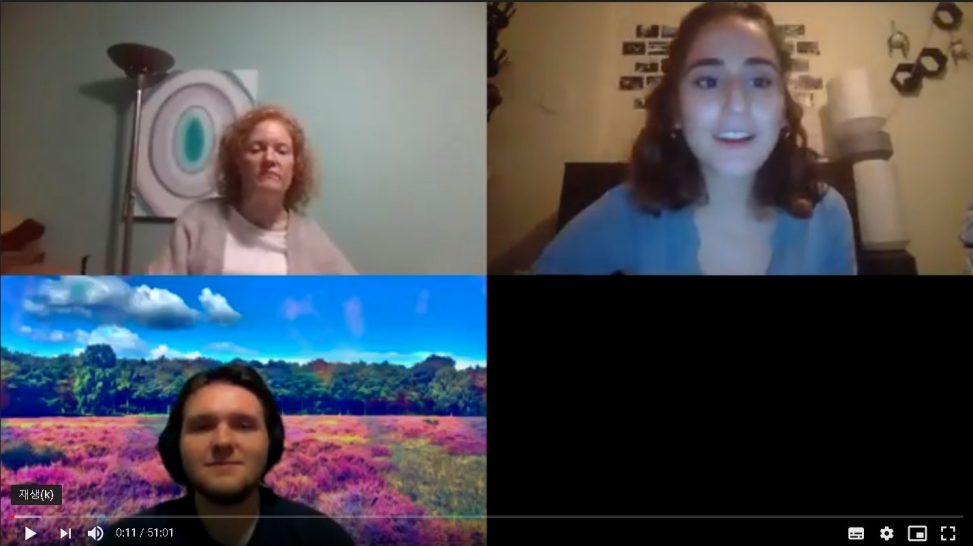Interviewing: Amy Shannon
Team: Dani, Evan, Daniel
INTRODUCTION
This project was designed to build a functioning device that can improve or help the daily life of disabled people. Our team, team AMY, was set to design an assistive device for Amy Shannon. Shannon had a spinal cord injury because of an accident before her 13th birthday. From that accident, she injured her C4 spinal cord, and half of her body got paralyzed especially with her legs and her hands.
In this interview, we are trying to learn her daily life route and her life so that we can understand her situation and build some device that can improve her life. Daniela Delgado, Daniel Moon, and Evan Tipping are planning to derive several ideas after finishing her interview, which will be discussed at end of the word press.
AGENDA
Before our interview, we prepared some possible questions to ask her in anticipation of how she might respond or how we might help her extract and identify problems in her daily life should the need arise. Our agenda is below:
Before we started an interview, we have discussed possible questions to ask Shannon to improve the quality of her interview. We used a google word document to gather some questions online and performed our meeting by using the Zoom meeting.
Here are some example questions we wrote on our Word Doc.
Question 1.
Can you walk us through a typical day in your life? What are some of the major events within your day and do you have any daily rituals?
Question 2.
Do you find certain daily tasks to be more frustrating to complete than others? Why?
Question 3.
Is there anything that you want to get into? A new hobby maybe?
Question 4.
If you had a device to help you with this task, how prevalent within your living space would you like it to be? Do you want it to be portable and on your person or stationary?
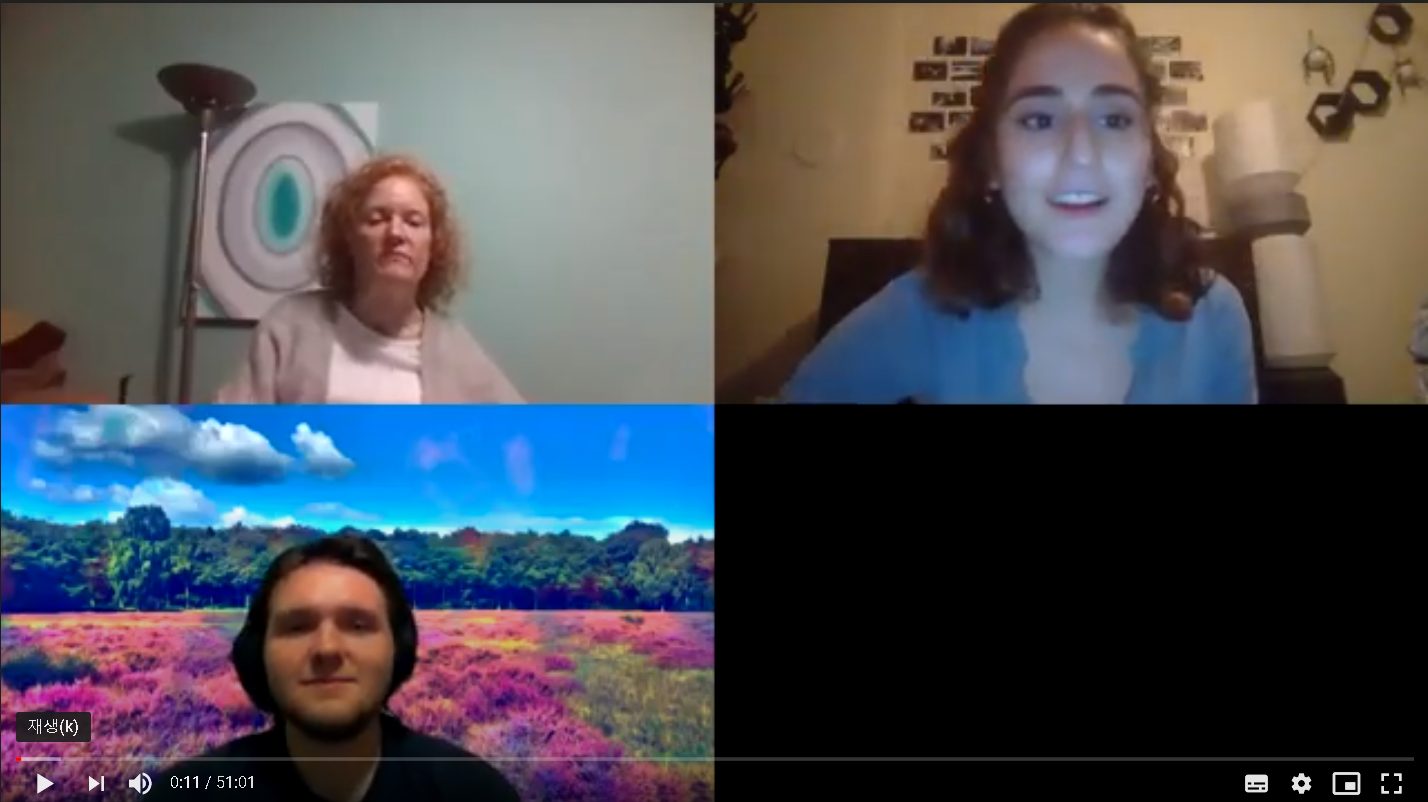
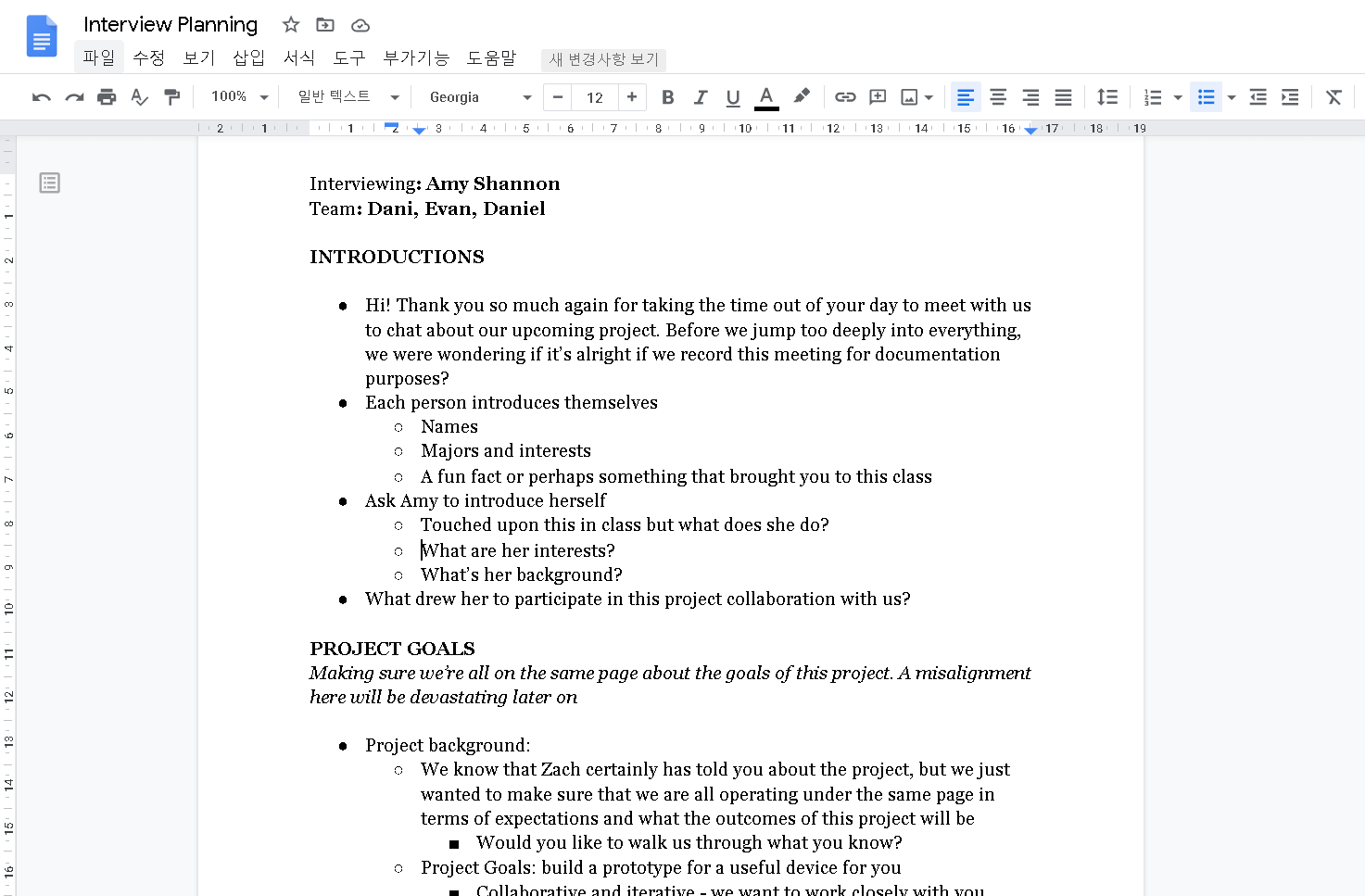
Through our interview planning, we have improved our quality a lot.
MEETING SUMMARY & MAJOR TAKEAWAYS
At the start of our conversation when we were introducing each other and ensuring that everyone was on the same page about the project deliverables, Amy began by noting that she did not have any particular ideas as to what type of device she would like or what she would like it to do – furthermore, she said that she wasn’t the best at coming up with ideas on-the-spot, and so she was a bit nervous that we wouldn’t leave the interview with many actionable concepts (Also, as a side note, having her comment that she wasn’t the best at on-the-spot thinking was very helpful to us as the next item on our agenda, after the project timeline overview, was an icebreaker activity where we all would come up with assistive device ideas quickly to get the ball rolling. We scrapped this part of the interview and jumped into questions about her daily life instead to avoid putting her in a potentially uncomfortable situation). We assured her that we would all work together to figure out a concept she was excited about and that she didn’t have to have any ideas for our project to bring to the table, just herself and her story. From here, we jumped into the meat and potatoes of the interview, where she told us about her daily life, her injury during adolescence which lead to her disability, and what she likes to do for fun (both by herself and with her aids and parents).
Throughout the interview, Amy introduced us to her attendant, April, who helps her in the morning and evenings to get ready for the day or for bed, walk her through muscle strengthening exercises, and assist her with tasks such as scrolling through shows on Netflix or completing her jewelry designs. Amy also spoke about her current assistive devices, such as her joy-stick controlled wheelchair, her splits which allow her to maintain wrist and ankle placement, her voice recognition software which helps her navigate her computer easier, and the camelback which she keeps attached to her chair so she doesn’t have to ask people to help her get water.
One interesting thing that she noted was that while you may think that something is a useful assistive device, such as a voice-controlled smart environment (i.e. an Amazon Alexa), in reality it’s not as helpful to a disabled person as you may believe. For instance, she doesn’t use voice-controlled speakers instead of asking April or another aid to use a remote to choose a TV show to watch because sometimes she doesn’t know what she specifically would like and just wants to see the options. A voice-controlled device requires a specific command, and so she doesn’t find them very helpful most of the time, even though she said most people would think that it would be helpful.
During the second half of the interview, we shifted from what she currently does in her day towards what she likes doing, even if it’s not a daily thing for her. This is when she got on the topic of art! She has always had an interest in all types of arts and crafts and carried that with her into life, getting her Masters’ degree from CMU in Arts Management. She likes different types of painting, and right now is interesting in acrylic pour styles of painting, but has stopped painting like she used to because there is a mismatch of assistive devices.
To paint, she needs an easel to rest the canvas on, her wheelchair, a mouthstick (which she described as a mouth guard-like device which has a paintbrush attached to it, allowing her to paint with her mouth), and someone to give her the paints. Her mouthstick is uncomfortable to use for prolonged periods of time, but she would still use it to paint until she got a new wheelchair which doesn’t let her close enough to her easel to paint.
We began to see if she’d be interested in a device that would allow her to create art in a more independent way since she loves it but is currently facing many barriers to it. Amy seemed to be really excited about the idea and so, with that, we began to wrap up the interview since we were about to go over an hour and it was late evening and so we didn’t want to keep her. We let her know that we would be in touch and are currently working on maintaining an open line of communication with her to make sure that she’s just as excited as we are in the project’s direction!
While this documentation outlines a basic overview of our meeting, we also decided to record the interview, with Amy’s consent, for future reference and personal documentation purposes. Furthermore, Dani and Daniel also typed notes throughout our conversation with Amy to see if there were any differences when it came to takeaways or things to note amongst the group.
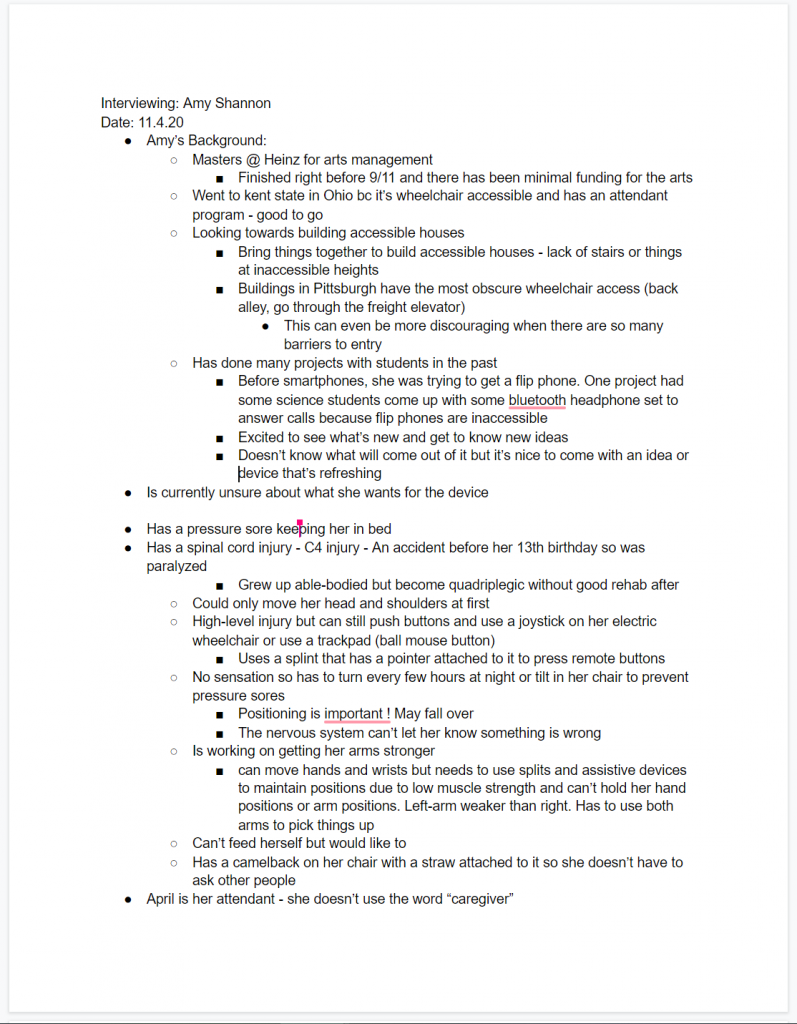
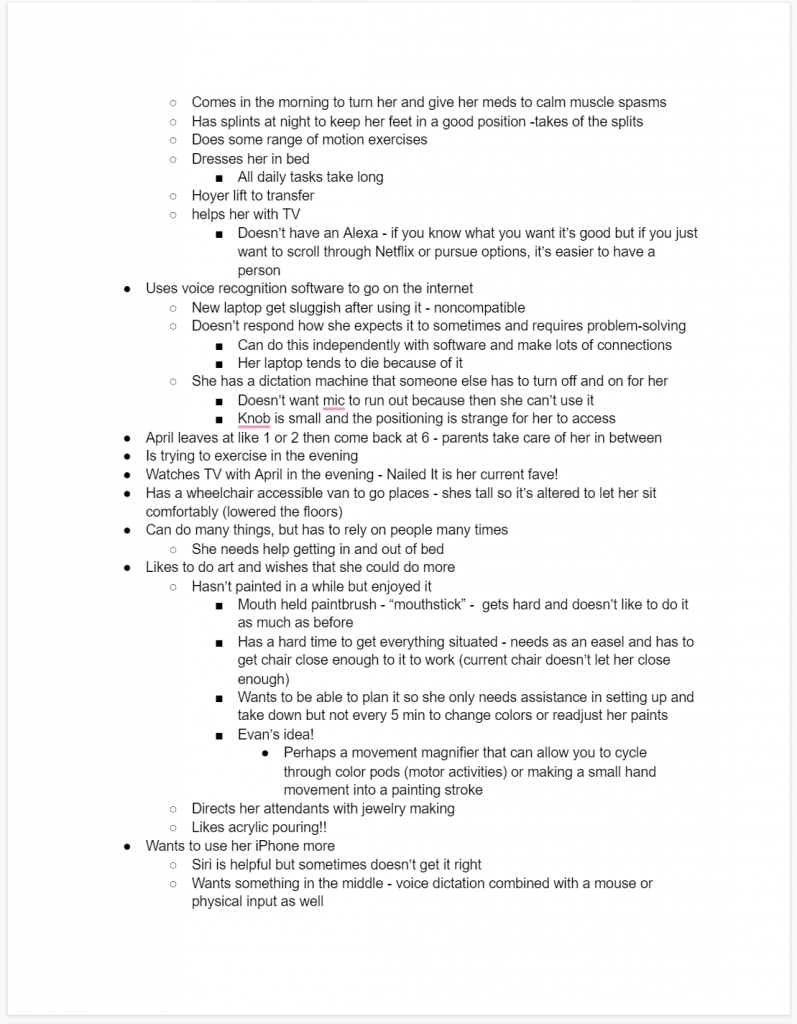
Dani’s Notes Document
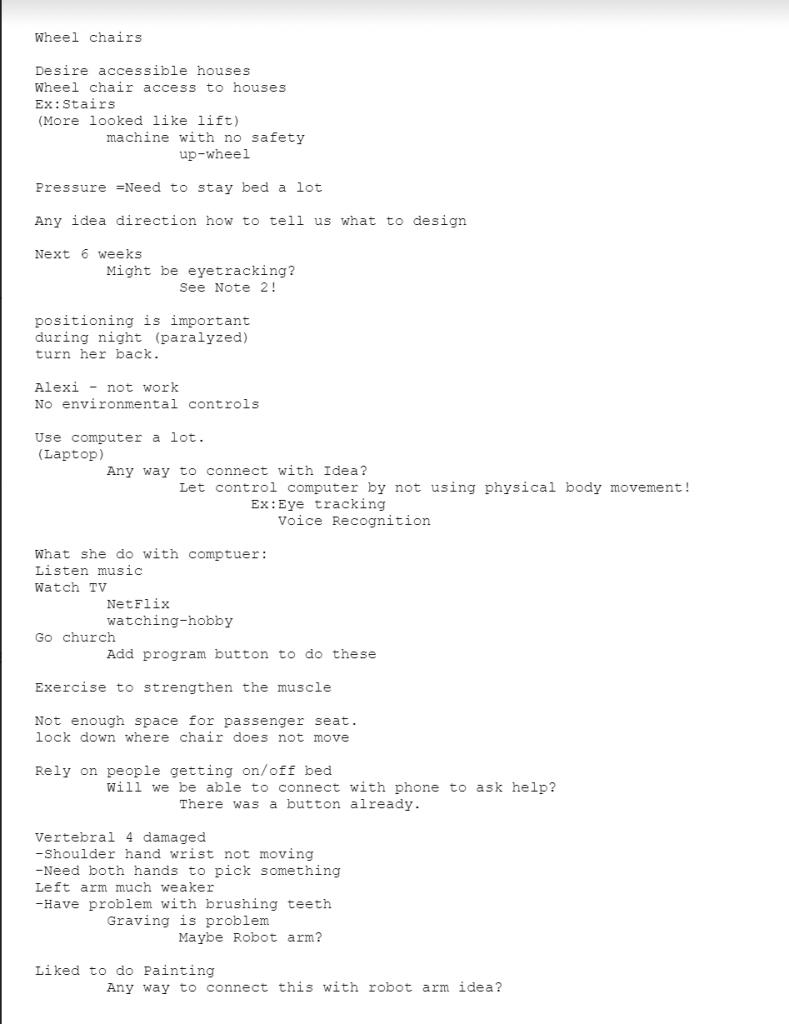
Daniel’s Notes Document
Major Interview Takeaways:
- Amy has limited movement due to a C4 spinal injury she got as a young teen. She needs assistance throughout the day to complete her daily tasks because of it
- Amy needs to use both hands to pick objects up but has enough movement with her hand to use a joystick
- She is currently going more strengthening and mobility exercises and is excited about her progress
- She uses many types of assistive devices, ranging from physical splints to speech recognition software
- It’s important to ask if something is actually helpful to a person with a disability instead of making assumptions
- Some things that you think would be helpful actually are not (or at least is subjective)
- Don’t make assumptions on what people can or cannot do – let them tell you
- Amy loves all types of art and would like to do more without having to ask for as much assistance as she currently has to
- There are many mismatches between her assistive devices which are currently causing barriers for her when it comes to painting
REFLECTION AND TEAM THOUGHTS
Overall, our interview with Amy took a more conversational tone; we used our interview agenda as a guide to lead the overall structure of the interview, but didn’t stick to a strict “next question on the agenda and answer” format, instead opting to ask impromptu followup questions based her comments and seeing where this lead us. We looped back to our agenda on occasion to ensure that all of the topics we wanted to cover were discussed, but most of our interview was us talking to Amy about her day-to-day life, what she likes to do, and what she wished she could do more during this time. While this proved to be an effective way for us to generate ideas with Amy since she wasn’t sure as to what she wanted, this approach may not be as helpful when interviewing other people who may prefer to give shorter and less anecdotal responses.
Furthermore, we wish that we could’ve incorporated more generative interviewing tactics to have a more active brainstorming session of ideas but, as we were unsure as to what her capabilities were to draw and she mentioned that she didn’t like on-the-spot thinking too much, we thought it was better to not interrupt the flow of conversation (as there weren’t many lulls in our interview which was a pleasant surprise!) by trying an activity.
After the interview and discussing the general direction of what type of project we wanted to make – an assistive device that facilitates the creation of art – we each began to generate concepts as to what this could look like. This allowed us to see where we were aligned as a group in terms of interests and where we weren’t: we all liked the idea of making painting easier for her by alleviating some of the mismatches she is experiencing when painting, but we didn’t have exact alignment on what type of device can provide the most succinct solution. We are currently leaning towards having there be a rig which moves a paintbrush by detecting and exaggerating her hand movements, but since we want to keep a clear line of communication with Amy to ensure that she’s happy with our project directions, we have sent her some of our sketches and are trying to coordinate another follow-up Zoom call to discuss her thoughts on them.
Ultimately, while our interview ended up deviating from our exact plan, we had a robust and fun conversation with Amy which let us get to know her better as a person and as a client. We are excited to continue to work with her throughout this process and see how far we can go with our project concept!
